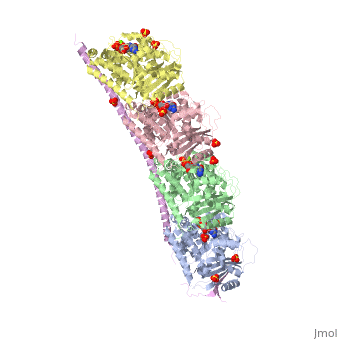Stathmin
From Proteopedia
(Difference between revisions)
| (2 intermediate revisions not shown.) | |||
| Line 1: | Line 1: | ||
<StructureSection load='3ryf' size='340' side='right' caption='Rat stathmin SLD domain (magenta) complex with tubulin α chain (grey, pink), tubulin β chain (green, yellow), GTP, sulfate and Mg+2 ions (PDB code [[3ryf]])' scene=''> | <StructureSection load='3ryf' size='340' side='right' caption='Rat stathmin SLD domain (magenta) complex with tubulin α chain (grey, pink), tubulin β chain (green, yellow), GTP, sulfate and Mg+2 ions (PDB code [[3ryf]])' scene=''> | ||
== Function == | == Function == | ||
| - | '''Stathmin-4''' (STM-4) regulates microtubules dynamics. Microtubules undergo continuous assembly and disassembly in the cell’s cytoskeleton. STM-4 binds to tubulin and prevents the latter from polymerization thus preventing microtubule assembly. Phosphorylation of STM-4 weakens the binding of STM-4 to tubulin enabling the microtubule assembly needed for the formation of mitotic spindle. Thus, STM-4 is an oncoprotein. STM-4 contains an SLD (Stathmin-Like Domain) domain of 149 residues which binds the tubulin dimer<ref>PMID:15216892</ref>. | + | '''Stathmin-4''' (STM-4) or '''stathmin-like protein B3''' regulates microtubules dynamics. Microtubules undergo continuous assembly and disassembly in the cell’s cytoskeleton. STM-4 binds to tubulin and prevents the latter from polymerization thus preventing microtubule assembly. Phosphorylation of STM-4 weakens the binding of STM-4 to tubulin enabling the microtubule assembly needed for the formation of mitotic spindle. Thus, STM-4 is an oncoprotein. STM-4 contains an SLD (Stathmin-Like Domain) domain of 149 residues which binds the tubulin dimer<ref>PMID:15216892</ref>. |
== Disease == | == Disease == | ||
Decreased levels of STM-4 are found in brains of adults with Down syndrome and Alzheimer disease<ref>PMID:11771751</ref>. | Decreased levels of STM-4 are found in brains of adults with Down syndrome and Alzheimer disease<ref>PMID:11771751</ref>. | ||
| - | |||
| - | </StructureSection> | ||
== 3D Structures of stathmin-4 == | == 3D Structures of stathmin-4 == | ||
| + | [[Stathmin-4 3D structures]] | ||
| - | + | </StructureSection> | |
| - | + | ||
| - | + | ||
| - | + | ||
| - | + | ||
| - | + | ||
| - | + | ||
| - | + | ||
| - | + | ||
| - | + | ||
| - | + | ||
| - | + | ||
| - | + | ||
| - | + | ||
| - | + | ||
| - | + | ||
| - | + | ||
| - | + | ||
| - | + | ||
| - | + | ||
| - | + | ||
| - | + | ||
| - | + | ||
| - | + | ||
| - | + | ||
| - | + | ||
| - | + | ||
| - | + | ||
| - | + | ||
| - | + | ||
| - | + | ||
| - | + | ||
| - | + | ||
| - | + | ||
| - | + | ||
| - | **[[5xiw]] – rSTM-4 + tubulin + tubulin tyrosine ligase + GTP + GDP + anti-gout drug <br /> | ||
| - | **[[5xke]] – rSTM-4 + tubulin + protein + GTP + GDP + anti-gout drug<br /> | ||
| - | **[[4o2b]] – rSTM + tubulin + tubulin tyrosine ligase + GTP + GDP + ATP derivative + anti-gout drug<br /> | ||
| - | **[[5xkh]] – rSTM-4 + tubulin + protein + GTP + GDP + anti-cancer drug<br /> | ||
| - | **[[4o4l]], [[5j2t]], [[5bmv]], [[5la6]], [[5jh7]], [[5jvd]], [[5fnv]], [[5c8y]], [[5ca0]], [[5ca1]], [[5cb4]], [[4yj2]], [[4yj3]], [[4x1i]], [[4x1k]], [[4x1y]], [[4x20]], [[4tuy]], [[4zol]], [[4tv8]], [[4tv9]], [[4o4j]], [[4o4l]], [[5i50]], [[4i4t]], [[4o4i]], [[4o2l]], [[5iyz]], [[5la6]], [[5m7e]], [[5m7g]], [[5m8d]], [[5m8g]], [[5xlt]], [[5yl4]], [[5xkg]], [[5xlt]], [[6fii]], [[6fjf]], [[6fjm]], [[5xlz]], [[4i50]] – rSTM-4 + tubulin + tubulin tyrosine ligase + GTP + GDP + ATP derivative + anti-cancer drugs<br /> | ||
| - | }} | ||
== References == | == References == | ||
<references/> | <references/> | ||
[[Category:Topic Page]] | [[Category:Topic Page]] | ||
Current revision
| |||||||||||
References
- ↑ Curmi PA, Gavet O, Charbaut E, Ozon S, Lachkar-Colmerauer S, Manceau V, Siavoshian S, Maucuer A, Sobel A. Stathmin and its phosphoprotein family: general properties, biochemical and functional interaction with tubulin. Cell Struct Funct. 1999 Oct;24(5):345-57. PMID:15216892
- ↑ Cheon MS, Fountoulakis M, Cairns NJ, Dierssen M, Herkner K, Lubec G. Decreased protein levels of stathmin in adult brains with Down syndrome and Alzheimer's disease. J Neural Transm Suppl. 2001;(61):281-8. PMID:11771751

